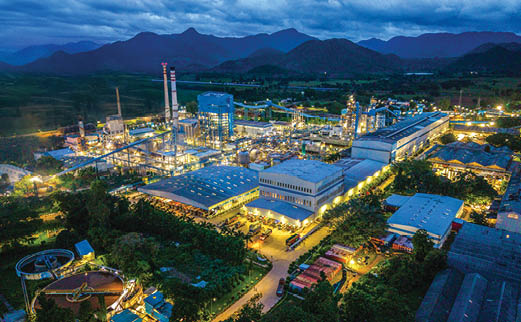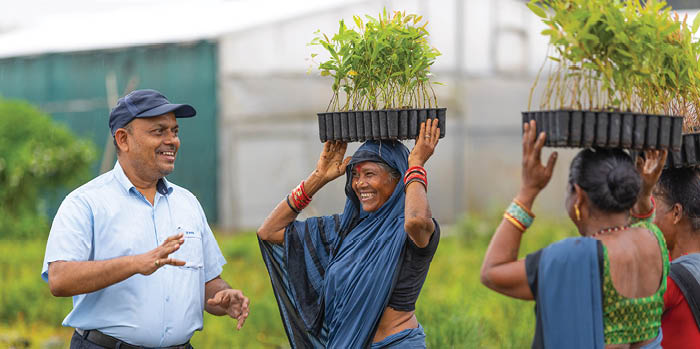JK Paper Limited, producing 100 percent virgin-grade packaging boards with an annual capacity over 3 lakh tonnes, maintains a strong pan-India presence. In an exclusive interaction with Paper Mart, Mr. Manoj Agrawal, Senior General Manager (Sales–Packaging), JK Paper Limited, shared that the company has recently invested in its BCTMP pulp mill, scheduled to be operational by the end of this year. Alongside strengthening its board line, JK Paper is expanding into the conversion line to gain deeper insights into customer needs and market trends. The company is also working closely with FMCG and food & beverage players on joint development projects, with a strong focus on innovative paperboard solutions as sustainable alternatives to plastic products.

Paper Mart: Could you begin by giving us an overview of your packaging paper and board operations – including your production capacity, facility locations, and manufacturing setup?
Manoj Agrawal: JK Paper Limited is a paper and packaging board company wherein we have three plants—one in Odisha, other in Gujarat and the third plant is in Telangana. Out of these three plants, we mainly produce packaging boards in our CPM plant in Gujarat. We have two machines BM4 and BM5 for producing quality packaging boards in our company. Our packaging board is manufactured 100 percent from pure virgin grade, with no use of recycled board.
We started our packaging board business in the year 2009 with the installation of a BM4 machine. At that time, the capacity of that machine was around 60,000 tonnes and today we are producing around 1,00,000 tonnes, with all the modifications and removing the bottlenecks.
Recently, we have invested in a new packaging board line BM5, a brand new machine from Valmet with an annual production capacity of about 1,70,000 tonnes. With this new machine, we are close to producing 2,00,000 tonnes of packaging board and we plan to take this capacity to 2,20,000 tonnes in the next one or two years, by removing all the bottlenecks.
We are also expanding our product portfolio to include higher GSM grades, which will help us further increase the machine’s production. With this expansion, our total production capacity currently standing at around 3,00,000 tonnes, is expected to rise to 3,20,000 tonnes.
Additionally, we operate a small multi-layer machine at our Telangana plant, which is dedicated to producing cup stock. This machine has a production capacity of about 40,000 tonnes per annum.
With all these additions, our total production capacity is around 3,60,000 tonnes. Alongside this, we operate integrated pulp mills across all our units, with dedicated pulp lines for producing chemical pulp in-house.

The packaging board market is growing at 6–7% annually, with the total market estimated to be over 17 lakh tonnes.
PM: Please walk us through your current product portfolio. What grades, GSM ranges, and end-use applications do you cater to, and are there any specialty packaging paper and board products you offer?
MA: We currently produce a wide range of products, including Folding Box Board (FBB), Solid Bleached Sulfate (SBS) boards, uncoated boards, cup stock, and several specialty grades. At our plant, we operate two machines—one dedicated to producing SBS boards and the other dedicated to FBB boards. This serves as a great advantage to serving our customers as each machine runs a single grade, ensuring efficiency and timely deliveries of customers’ orders. This is a key USP for us.
In terms of GSM, our product range spans from 190 GSM to 400 GSM across all categories. Additionally, we manufacture specialty products such as cigarette boards, antifungal boards, aqueous barrier-coated boards, and poly-extrusion boards. We also have a fully integrated in-house extrusion facility at our plant.
Watch: In Pursuit of Lesser Water Footprint
PM: Can you tell us about the key domestic and international markets in the packaging grade segment?
MA: We, as a company, always believe in having a pan-India presence. For our products—be it copier paper, maplitho, or any other segment—JK Paper’s strength lies in its deep distribution network across the country. Just as we have a pan-India presence in copier paper, we also enjoy nationwide reach in our packaging board segment, with our products available across India.
That being said, we focus more on markets closer to our factories, as this gives us an advantage in terms of logistics costs and ensures better service to our customers.
One of our plants is located in the western part of India, one of the biggest markets for packaging, while also being close to the northern market, which is rapidly growing. All in all, our plant is strategically positioned compared to competition—well-placed both in terms of production facility and proximity to high-potential markets.

We have invested in a new packaging board line called BM5, a brand new machine from Valmet with an annual production capacity of about 1,70,000 tonnes. With this new machine, we are close to producing 2,00,000 tonnes of packaging board and we plan to take this capacity to 2,20,000 tonnes in the next one or two years.
PM: Can you shed light on the recent developments in the company in the packaging segment? How has the market evolved over the years in the packaging segment?
MA: We are not only investing in the board line but also expanding into the conversion line. The idea is to better understand our customers—their needs, and the requirements of the end-users, who are the brand owners, in terms of packaging. With the growing demand for sustainable products, it is important to analyze what future sustainable products that are needed in the market. It is important to align with future market needs. By gaining deeper insights into this business, we believe we can produce better boards that truly meet customer requirements.

India today is highly capable of producing not only high-quality boards but also good quality converted boards. The technological advancements happening in the printing lines are significantly ahead of developments in packaging board production itself. This is because most converting machinery now comes from countries like Germany, Japan, and Korea, and these machines are highly sophisticated.
Earlier, Indian converters largely relied on second-hand equipment—machines that were 6–7 years old, such as Heidelberg machines, purchased at 30–40% of the cost of a new one. However, the trend has now shifted. Indian converters are increasingly investing in brand-new machines equipped with multiple functions—eight-color jobs, UV coating, embossing, and other value-added capabilities. These enable them to meet a wide range of customer requirements.
As a result, Indian converters are now fully capable of delivering the quality standards required by FMCG, pharmaceutical, and food & beverage industries for their monocartons. As a country, we are well-positioned to meet these evolving needs.
PM: Sustainability is becoming a cornerstone of the packaging sector. What steps have you taken to integrate environmentally responsible practices into your manufacturing and sourcing?
MA: The most critical aspect of paper and board production is raw material, which essentially comes from wood. JK Paper is one company that recognized this need over 10–15 years ago and invested heavily in plantation activities. Every year, we undertake plantation drives covering about 35,000 hectares, planting nearly 12 crore trees annually through our social farm forestry model—since land ownership is not permitted in India.
To support this effort, we maintain large nurseries and have state-of-the-art R&D facilities at our plants, enabling us to develop high-quality saplings and accelerate growth cycles so farmers can harvest yields in 2–3 years as compared to much longer time duration earlier. This increases farmers’ earnings while ensuring a reliable, high-quality, and cost-efficient wood supply for us.
On average, each tonne of paper requires about 3–3.5 tonnes of wood, so logistics also play a vital role. We have expanded our green cover and as a result JK Paper has become a carbon-positive company. We grow more trees than we consume, contributing positively to the environment.
Beyond raw materials, we are also focused on energy and water sustainability. At our CPM plant in Gujarat, nearly 40% of our fuel is non-fossil based, biofuel. Going forward, we are targeting 100% biofuel usage by 2030. Our team is working on this goal and we may even succeed in this target much earlier, by 2028–29. Our plants are designed to minimize both water and energy consumption, as we are investing in new machineries which require much less water and energy. In the long run, this upgrade will give us a cost advantage, and at the same time, it will also take care of the environment.
On the consumer side, we are helping customers transition from plastic to paper-based solutions. For instance, we have developed aqueous barrier-coated paper/ paper cups as an alternative to poly-extruded paper cups. Unlike poly-coated cups, which take years to degrade, our aqueous barrier-coated cups decompose naturally within six to eight months. Once regulatory restrictions on poly-coated cups are enforced, we expect significant growth in its (aqueous barrier-coated cups) volume.
Similarly, we have developed antifungal boards that eliminate the need for poly-lamination in soap packaging or any other packaging, offering a more sustainable solution to avoid fungal growth.
In essence, we are continuously exploring possibilities to replace plastic with paperboard, and poly-extrusion, with more sustainable alternatives. This will reinforce our commitment to the environment and support customers’ shift towards greener solutions.

We have developed aqueous barrier-coated paper as an alternative to poly-extruded paper. Unlike poly-coated paper, our aqueous barrier-coated cups decompose naturally within six to eight months.
PM: What are some of the most significant technological upgrades or process improvements you’ve made recently in your mills to enhance quality, reduce waste, or optimize energy usage?
MA: The investment we made in the brand new state-of-the-art multilayer board machine (BM5) by Valmet in 2021 was close to INR 2,000 crore. More recently, we have also invested about INR 700 crore in our BCTMP pulp mill, which will be operational by the end of this year.
On the technology front, we began collaborating with a consultant 2–3 years ago to drive digitalization across the company—covering production, marketing and sales, finance, HR, procurement, and more. We have effectively transitioned into Industry 4.0.
Today, we have a strong in-house IT team, and every production parameter is mapped with sensors. This enables us to reduce downtime, minimize finishing losses, and optimize machine efficiency. As a result, JK Paper has emerged as one of the leading companies in implementing digitalization at the factory level in a practical sense.
The biggest advantage has been on the manufacturing side, where our IT and production teams have worked tirelessly together. Our efforts were recognized about one and a half years ago when we received an award for Industry 4.0, acknowledging the progress we have made in digitalizing our operations.

Earlier, Indian converters largely relied on second-hand equipment—machines that were 6–7 years old. However, the trend has now shifted. Indian converters are increasingly investing in brand-new machines equipped with multiple functions—eight-color jobs, UV coating, embossing, and other value-added capabilities
PM: Are you seeing a shift in customer preference toward higher-strength or lightweight packaging paper and board variants? How are you balancing performance with cost-efficiency in product development?
MA: When we talk about higher-strength paper in packaging boards, it essentially comes down to higher bulk. We are able to meet customer requirements by producing boards with a bulk in range of 1.6 to 1.7, which is what our customers require. Beyond this, there isn’t much additional requirement, and we are fully capable of manufacturing and supplying such boards.
In terms of lightweight packaging paper, when the bulk increases, the GSM requirement naturally comes down. For example, customers who earlier purchased 300 GSM are now opting for 290 or even 280 GSM, as bulk goes up. This allows us to provide better quality products as compared to imports that are coming in and this gives us a strong competitive edge.

PM: What are the major challenges you currently face as a packaging paper and board manufacturer– be it raw material volatility, energy costs, logistics, or regulatory changes? How are you navigating them?
MA: Currently, we are facing a couple of challenges, the foremost being raw material prices. Due to COVID-related disruptions, plantations were limited during the lockdown period, leading to reduced wood availability. This shortage has impacted the entire paper industry, including us. As a result, raw material costs today are nearly double compared to two years ago. While input costs have increased substantially, selling prices have declined, leaving either no margins or extremely thin ones—particularly in the packaging board segment. Profitability has therefore become a challenge across the industry.
The second challenge is the huge new capacities which have come across in packaging boards, particularly from Indonesia and China over the past two years. In the coming 2 to 4 years, nearly 90 lakh tonnes of fresh virgin capacity is expected to be added, with about 50 to 60 lakh tonnes already added by China and Indonesia, and another 30 to 40 lakh tonnes likely to be added in next 1-2 years.
Though these mills are primarily meant to cater to markets in China, Europe, and the U.S., until those capacities are absorbed by those markets, the companies are dumping excess boards in India at prices even below pulp costs.
Adding to this challenge, countries like Indonesia have zero import duty when supplying to India, coupled with lower sea freight costs—just 3–4% compared to more than 5% for inland logistics from let say, Gujarat to Delhi. As a result, port cities such as Mumbai, Chennai, Visakhapatnam, and Kolkata are flooded with cheaper imports, and tap even northern markets like Delhi that are now accessible from ports like Kandla and Mundra through improved rail connectivity.
The only silver lining is the good growth of the packaging segment. The packaging board market is growing at 6–7% annually, with the total market estimated to be over 17 lakh tonnes. So we need an additional requirement of nearly 1–1.5 lakh tonnes of capacity every year to feed this market. While this indicates healthy growth potential, the domestic profitability does not align with this market growth. So, we need to carefully evaluate this situation before deciding on capacity expansion.
Also Read: Khanna Paper Mills Carves a Niche in the Packaging Board Segment, Focussing on FMCG Sector
PM: Looking ahead, what’s your strategic roadmap in terms of capacity expansion, backward integration, export push, product diversification? How do you envision your mill’s role in the global packaging paper and board value chain in the next 5 years?
MA: Going forward, we plan to enhance our capacities by de-bottlenecking existing operations. We may also consider investing in a new board line, although it is not an immediate decision and will depend entirely on the return on investment (ROI). In fact, even with the investments made in the last two years—whether in forward integration or backward integration—we are yet to achieve the expected ROI.

The bigger concern at present is the influx of cheap imports, which is severely impacting the industry. Any country can truly grow only when it utilises its domestic capability which is the essence of ‘Atmanirbhar Bharat’. We have the talent, resources, and infrastructure to do so. The paper and packaging industry is ready to invest, but the problem lies in the dumping of low-cost imports, particularly from countries like Indonesia and China.
The Free Trade Agreement (FTA) with ASEAN countries has severely impacted the domestic market, creating a major challenge for companies like us. For instance, in Indonesia, abundant wood availability reduces production costs by nearly 30% compared to India, making it easy for them to dump products here at unsustainable prices. If such imports were curtailed,we will without wait invest in new machines and increase our capacity. This would not only generate significant employment but also benefit farmers—who often remain outside the limelight. The government should step in and safeguard the domestic industry.

The Free Trade Agreement (FTA) with ASEAN countries has severely impacted the domestic market, creating a major challenge for companies like us. For instance, in Indonesia, abundant wood availability reduces production costs by nearly 30% compared to India, making it easy for them to dump products here at unsustainable prices.



